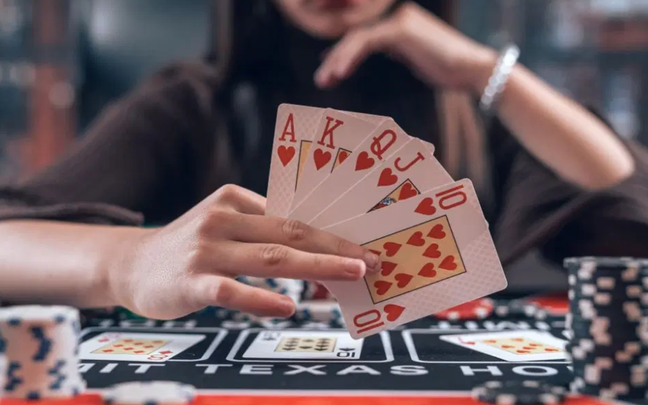Balancing your range in poker is an important strategy that helps you avoid having your hand read by opponents while optimizing your decisions during the game. By combining strong and weak hands in a well-balanced manner, you can create unpredictability and put pressure on your opponents.
This article will help you gain a better understanding of the concept of range balancing, as well as how to apply it effectively in poker.

Balancing your range in poker helps you avoid being easily read by your opponents
Balancing your range in poker
Balancing your range in poker is a key factor that helps you become a successful player. Understanding and applying this strategy will help protect your hand from being easily read by your opponents while also improving your ability to read your opponents’ hands effectively.
What is the concept of a range in poker?
To understand range balancing, we first need to understand the concept of a range. In poker, a range refers to the set of hands you could have in a given situation. For example, when you raise before the flop, your range could include a variety of hands, from strong hands like AA or KK to weaker hands like 9♠9♦ or even hands like 7♠2♣ in riskier plays.
You build your range based on factors such as your position at the table, your opponent's actions, and your overall strategy in that hand. Specifically, your range can change depending on the stage of the hand (pre-flop, post-flop, turn, river) and various other factors.
The concept of range balancing
Range balancing is a strategy that involves playing both strong and weak hands in a reasonable ratio to make it difficult for opponents to read your hand. Balancing your range doesn’t mean playing a fixed percentage of strong or weak hands, but rather combining hand types with a frequency that makes it hard for your opponents to know what you have based solely on your actions.
In other words, a player who balances their range won’t just play aggressively with strong hands like AA or KK; they will also play some weak hands like 7♠2♣ with the same level of confidence and strategy. This way, opponents cannot accurately determine whether you have a strong hand or not, making it difficult for them to make the right decision.
One of the fundamental principles of range balancing is to prevent your opponents from exploiting you when they learn your habits. If you always play strong hands in a certain situation, your opponents will catch on and adjust their strategy to counter you. However, if you consistently mix strong and weak hands, they won’t be able to make the right decision.

Balancing your range creates unpredictability, making it difficult for your opponents to make an accurate decision
Balancing your range in different stages of the game
To balance your range in poker, you need to apply this strategy at each stage of the hand. Each stage of a poker hand has its own characteristics, and using strong or weak hands appropriately can help create unpredictability for your opponents.
Pre-flop
Before the flop is dealt, you need to determine your range. Typically, in this stage, a player balancing their range will not only play strong hands (like AA, KK) but may also include hands like suited connectors (e.g., 9♠8♠) or weaker hands like J♣10♦, hoping to hit strong hands on the flop. This creates uncertainty for your opponent, as they must guess your hand.
Additionally, in the pre-flop stage, you can use strategies like bluffing or semi-bluffing to make it harder for your opponent to easily determine what you are holding. For example, you might raise with weak hands like A♠2♣ to apply pressure on your opponent, making it difficult for them to know whether you have a strong hand.
Post-flop, Turn, and River
When the community cards are dealt (flop, turn, river), you need to continue maintaining your balanced range. In these stages, it’s important not to let your opponent figure out that you have a specific hand.
For example, if the flop comes K♠J♠7♦, you might have a pair of kings or jacks, or you could have a weak hand like 3♦4♣. In both cases, you might continue betting or raising in certain situations, but there’s no way for your opponent to be sure what you hold. This helps maintain unpredictability, making it more difficult for your opponent to decide if you have a strong hand.

Balancing your range helps you maintain flexibility in each hand
Why is range balancing important in poker?
Range balancing plays a crucial role in poker because it helps you avoid being exploited by your opponents. If you only play strong hands or only weak hands in certain situations, your opponents will easily notice and adjust their strategy to beat you.
Range balancing allows you to:
Increase unpredictability: When you play a range of strong and weak hands, your opponents won’t be able to rely on your actions to guess what you have.
Put pressure on your opponents: By using a diverse range, your opponents will face more difficult decisions when up against you, as they can't be sure what hand you hold.
Reduce the chances of being exploited: If you are too predictable, your opponents can exploit your weaknesses. Range balancing helps minimize this, making you harder to exploit.
Range balancing is a powerful strategy that helps you create unpredictability and reduce the risk of being exploited by your opponents. By applying range balancing, you not only maintain flexibility in various situations but also optimize your strategy in making the right decisions.

Range balancing helps optimize your strategy in every situation.
When you use range balancing effectively, you can apply pressure on your opponents and maximize your profits in every poker hand.























